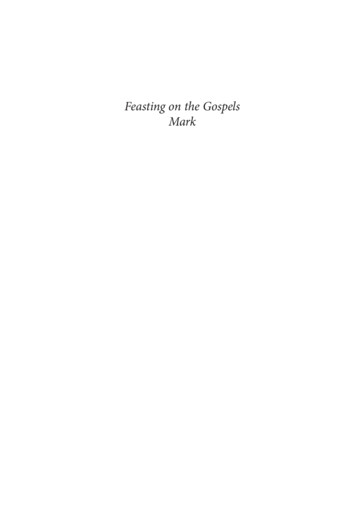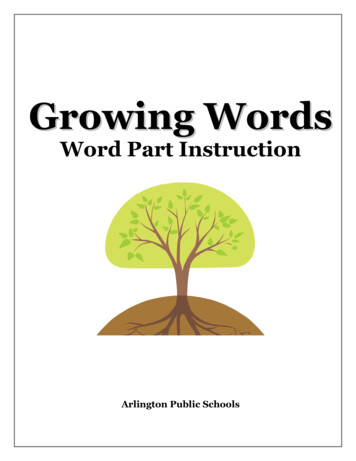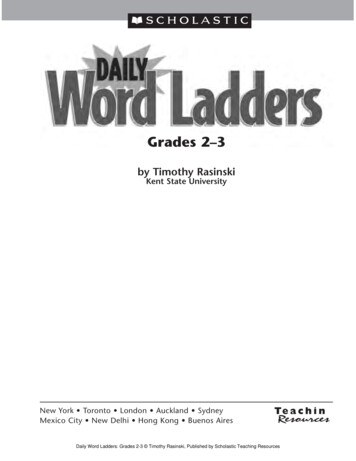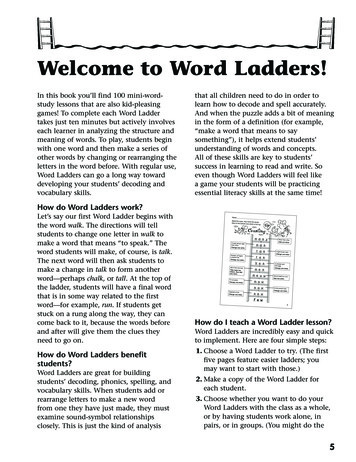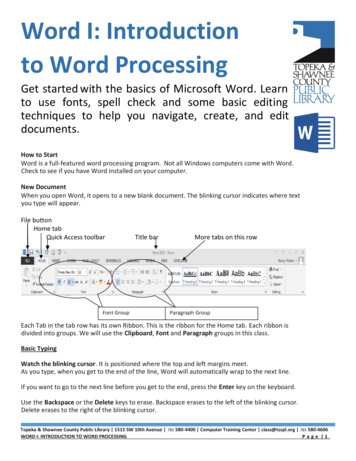
Transcription
Feasting on the Word
Editorial BoardGeneral EditorsDavid L. Bartlett (American Baptist Churches USA), Professor Emeritus of NewTestament, Columbia Theological Seminary, Decatur, GeorgiaBarbara Brown Taylor (The Episcopal Church), Harry R. Butman Professor ofReligion, Piedmont College, Demorest, GeorgiaVolume EditorsCharles L. Campbell (Presbyterian Church (U.S.A.)), Professor of Homiletics,Duke Divinity School, Durham, North CarolinaCarlos Cardoza-Orlandi (Christian Church [Disciples of Christ] in the U.S.A. andCanada and La Iglesia Cristiana [Discipulos de Cristo] en Puerto Rico), Professorof Global Christianities and Mission Studies, Perkins School of Theology,Southern Methodist University, Dallas, TexasGary W. Charles (Presbyterian Church (U.S.A.)), Pastor, Central PresbyterianChurch, Atlanta, GeorgiaAllen Hilton (United Church of Christ), Minister of Faith and Learning, WayzataCommunity Church, Wayzata, MinnesotaCynthia A. Jarvis (Presbyterian Church (U.S.A.)), Minister and Head of Staff, ThePresbyterian Church of Chestnut Hill, Philadelphia, PennsylvaniaE. Elizabeth Johnson (Presbyterian Church (U.S.A.)), J. Davison Philips Professorof New Testament, Columbia Theological Seminary, Decatur, GeorgiaThomas G. Long (Presbyterian Church (U.S.A.)), Bandy Professor of Preaching,Candler School of Theology, Emory University, Atlanta, GeorgiaKathleen M. O’Connor (Roman Catholic Church), William Marcellus McPheetersProfessor of Old Testament, Columbia Theological Seminary, Decatur, GeorgiaMarcia Y. Riggs (African Methodist Episcopal Zion Church), J. Erskine LoveProfessor of Christian Ethics, Columbia Theological Seminary, Decatur,GeorgiaGeorge W. Stroup (Presbyterian Church (U.S.A.)), J. B. Green Professor ofTheology, Columbia Theological Seminary, Decatur, GeorgiaEmilie M. Townes (American Baptist Churches USA), Associate Dean ofAcademic Affairs and Andrew W. Mellon Professor of African AmericanReligion and Theology, Yale Divinity School, Yale University, New Haven,ConnecticutRichard F. Ward (United Church of Christ), Fred B. Craddock Professor ofHomiletics and Worship, Phillips Theological Seminary, Tulsa, OklahomaProject ManagerJoan Murchison, Columbia Theological Seminary, Decatur, GeorgiaProject CompilerMary Lynn Darden, Columbia Theological Seminary, Decatur, Georgia
Feasting on the Word Preaching theRevised Common LectionaryYear A, Volume 1David L. Bartlett and Barbara Brown TaylorGeneral Editors
2010 Westminster John Knox PressAll rights reserved. No part of this book may be reproduced or transmitted in any form or by any means, electronic ormechanical, including photocopying, recording, or by any information storage or retrieval system, without permission inwriting from the publisher. For information, address Westminster John Knox Press, 100 Witherspoon Street, Louisville,Kentucky 40202-1396.Unless otherwise indicated, Scripture quotations are from the New Revised Standard Version of the Bible, copyright 1989 by the Division of Christian Education of the National Council of the Churches of Christ in the U.S.A., and areused by permission. All rights reserved. Scripture quotations marked JPS are from The TANAKH: The New JPS Translationaccording to the Traditional Hebrew Text. Copyright 1985 by the Jewish Publication Society. Used by permission. Scripturequotations marked NIV are from The Holy Bible, New International Version. Copyright 1973, 1978, 1984 International BibleSociety. Used by permission of Zondervan Bible Publishers.Excerpts from Ron Ingram’s, “‘Holiness in the Hood’ draws youth to neighborhood church celebration,” by Ron Ingram,Herald&Review.com, July 21, 2008, are used by permission. Excerpts from an unpublished paper by the Rev. Doug King,Senior Associate Pastor, Brick Presbyterian Church, New York, presented to the Moveable Feast group in 2008 are used bypermission. Excerpt from“A Christmas Hymn” in Advice to a Prophet and Other Poems, copyright 1961 and renewed 1989by RichardWilbur, reprinted by permission of Houghton Mifflin Harcourt Publishing Company and Faber and Faber Ltd.Excerpts from Remember Who You Are: Baptism, a Model for Christian Life, byWilliam H.Willimon, copyright 1980 by TheUpper Room (Nashville, TN). Used by permission from the publisher.Book design by Drew StevensCover design by Lisa Buckley2013 paperback editionOriginally published in hardback in the United Statesby Westminster John Knox Press in 2010Louisville, KentuckyThis book is printed on acid-free paper that meets the American National Standards Institute Z39.48 standard.13 14 15 16 17 18 19 20 21 22 —10 9 8 7 6 5 4 3 2 1Library of Congress Cataloging-in-Publication DataFeasting on the Word : preaching the revised common lectionary / David L. Bartlett and Barbara Brown Taylor, generaleditors.p. cm.Includes index.ISBN 978-0-664-23107-1 (v. 12 alk. paper)ISBN 978-0-664-23106-4 (v. 11 alk. paper)ISBN 978-0-664-23105-7 (v. 10 alk. paper)ISBN 978-0-664-23104-0 (v. 9 alk. paper)ISBN 978-0-664-23103-3 (v. 8 alk. paper)ISBN 978-0-664-23102-6 (v. 7 alk. paper)ISBN 978-0-664-23101-9 (v. 6 alk. paper)ISBN 978-0-664-23100-2 (v. 5 alk. paper)ISBN 978-0-664-23099-9 (v. 4 alk. paper)ISBN 978-0-664-23098-2 (v. 3 alk. paper)ISBN 978-0-664-23097-5 (v. 2 alk. paper)ISBN 978-0-664-23096-8 (v. 1 alk. paper)1. Lectionary preaching. 2. Common lectionary (1992) I. Bartlett, David Lyon, 1941– II. Taylor, Barbara Brown.BV4235.L43F43 2008251'.6—dc222007047534ISBN 978-0-664-23957-2 (v. 12 paperback)ISBN 978-0-664-23954-1 (v. 11 paperback)ISBN 978-0-664-23963-3 (v. 10 paperback)ISBN 978-0-664-23960-2 (v. 9 paperback)ISBN 978-0-664-23959-6 (v. 8 paperback)ISBN 978-0-664-23956-5 (v. 7 paperback)ISBN 978-0-664-23965-7 (v. 6 paperback)ISBN 978-0-664-23962-6 (v. 5 paperback)ISBN 978-0-664-23958-9 (v. 4 paperback)ISBN 978-0-664-23955-8 (v. 3 paperback)ISBN 978-0-664-23964-0 (v. 2 paperback)ISBN 978-0-664-23961-9 (v. 1 paperback)
000 Bartlett Vol 9 FMT (i-x):Layout 16/2/112:48 PMPage vContentsvii Publisher’s Noteviii Series Introductionix A Note about the LectionaryF I R S T S U N DAY O F A D V E N T Isaiah 2:1–5Psalm 122Romans 13:11–14Matthew 24:36–44S E CO N D S U N DAY O F A D V E N T Isaiah 11:1–10Psalm 72:1–7, 18–19Romans 15:4–13Matthew 3:1–12T H I R D S U N DAY O F A D V E N T Isaiah 35:1–10Psalm 146:5–10James 5:7–10Matthew 11:2–11F O U R T H S U N DAY O F A D V E N T Isaiah 7:10–16Psalm 80:1–7, 17–19Romans 1:1–7Matthew 1:18–25C H R I S T M A S DAY Isaiah 52:7–10Psalm 98Hebrews 1:1–4 (5–12)John 1:1–14F I R S T S U N DAY A F T E R C H R I S T M A S DAY Isaiah 63:7–9Psalm 148Hebrews 2:10–18Matthew 2:13–23S E CO N D S U N DAY A F T E R C H R I S T M A S DAY Sirach 24:1–12Wisdom of Solomon 10:15–21Ephesians 1:3–14John 1:(1–9) 10–18E P I P H A NY O F T H E LO R D Isaiah 60:1–6Psalm 72:1–7, 10–14Ephesians 3:1–12Matthew 2:1–12B A P T I S M O F T H E LO R D ( F I R S T S U N DAY A F T E RT H E E P I P H A NY ) Isaiah 42:1–9Psalm 29Acts 10:34–43Matthew 3:13–17CHRISTMAS EVE Isaiah 9:2–7Psalm 96Titus 2:11–14Luke 2:1–14 (15–20)S E CO N D S U N DAY A F T E R T H E E P I P H A NY Isaiah 49:1–7Psalm 40:1–111 Corinthians 1:1–9John 1:29–42
000 Bartlett Vol 9 FMT (i-x):Layout 16/2/11T H I R D S U N DAY A F T E R T H E E P I P H A NY Isaiah 9:1–4Psalm 27:1, 4–91 Corinthians 1:10–18Matthew 4:12–232:48 PMPage viS E V E N T H S U N DAY A F T E R T H E E P I P H A NY Leviticus 19:1–2, 9–18Psalm 119:33–401 Corinthians 3:10–11, 16–23Matthew 5:38–48F O U R T H S U N DAY A F T E R T H E E P I P H A NYE I G H T H S U N DAY A F T E R T H E E P I P H A NY Micah 6:1–8Psalm 151 Corinthians 1:18–31Matthew 5:1–12F I F T H S U N DAY A F T E R T H E E P I P H A NY Isaiah 58:1–9a (9b–12)Psalm 112:1–9 (10)1 Corinthians 2:1–12 (13–16)Matthew 5:13–20S I X T H S U N DAY A F T E R T H E E P I P H A NY Deuteronomy 30:15–20Psalm 119:1–81 Corinthians 3:1–9Matthew 5:21–37Isaiah 49:8–16aPsalm 1311 Corinthians 4:1–5Matthew 6:24–34N I N T H S U N DAY A F T E R T H E E P I P H A NY Deuteronomy 11:18–21, 26–28Psalm 31:1–5, 19–24Romans 1:16–17; 3:22b–28 (29–31)Matthew 7:21–29L A S T S U N DAY A F T E R T H E E P I P H A NY( T R A N S F I G U R AT I O N S U N DAY ) Exodus 24:12–18Psalm 22 Peter 1:16–21Matthew 17:1–9 Contributors Scripture Index Author Indexvi
Publisher’s NoteFeasting on the Word: Preaching the Revised CommonLectionary is an ambitious project that is offered tothe Christian church as a resource for preaching andteaching.The uniqueness of this approach in providing fourperspectives on each preaching occasion from theRevised Common Lectionary sets this work apart fromother lectionary materials. The theological, pastoral,exegetical, and homiletical dimensions of each biblicalpassage are explored with the hope that preachers willfind much to inform and stimulate their preparationsfor preaching from this rich “feast” of materials.This work could not have been undertakenwithout the deep commitments of those whohave devoted countless hours to working on thesetasks. Westminster John Knox Press would like toacknowledge the magnificent work of our generaleditors, David L. Bartlett and Barbara Brown Taylor.They are both gifted preachers with passionateconcerns for the quality of preaching. They are alsowonderful colleagues who embraced this huge taskwith vigor, excellence, and unfailing good humor.Our debt of gratitude to Barbara and David is great.The fine support staff, project manager JoanMurchison and compiler Mary Lynn Darden,enabled all the thousands of “pieces” of the projectto come together and form this impressive series.Without their strong competence and abidingpersistence, these volumes could not have emerged.The volume editors for this series are to bethanked as well. They used their superb skills aspastors and professors and ministers to work withwriters and help craft their valuable insights into thehighly useful entries that comprise this work.The hundreds of writers who shared theirexpertise and insights to make this series possible areones who deserve deep thanks indeed. They comefrom wide varieties of ministries. They have giventheir labors to provide a gift to benefit the wholechurch and to enrich preaching in our time.Westminster John Knox would also like toexpress our appreciation to Columbia TheologicalSeminary for strong cooperation in enabling thiswork to begin and proceed. Dean of Faculty andExecutive Vice President D. Cameron Murchisonwelcomed the project from the start and drewtogether everything we needed. His continuingefforts have been very valuable. Former PresidentLaura S. Mendenhall provided splendid help aswell. She made seminary resources and personnelavailable and encouraged us in this partnershipwith enthusiasm and all good grace. We thank herand look forward to working with Columbia’s newpresident, Stephen Hayner.It is a joy for Westminster John Knox Press topresent Feasting on the Word: Preaching the RevisedCommon Lectionary to the church, its preachers, andits teachers. We believe rich resources can assist thechurch’s ministries as the Word is proclaimed. Webelieve the varieties of insights found in these pageswill nourish preachers who will “feast on the Word”and who will share its blessings with those who hear.Westminster John Knox Pressvii
Series IntroductionA preacher’s work is never done. Teaching,offering pastoral care, leading worship, andadministering congregational life are only a few ofthe responsibilities that can turn preaching into justone more task of pastoral ministry. Yet the Sundaysermon is how the preacher ministers to most of thepeople most of the time. The majority of those wholisten are not in crisis. They live such busy lives thatfew take part in the church’s educational programs.They wish they had more time to reflect on theirfaith, but they do not. Whether the sermon is fiveminutes long or forty-five, it is the congregation’sone opportunity to hear directly from their pastorabout what life in Christ means and why it matters.Feasting on the Word offers pastors focusedresources for sermon preparation, written bycompanions on the way. With four different essays oneach of the four biblical texts assigned by the RevisedCommon Lectionary, this series offers preacherssixteen different ways into the proclamation of God’sWord on any given occasion. For each reading,preachers will find brief essays on the exegetical,theological, homiletical, and pastoral challenges of thetext. The page layout is unusual. By setting the biblicalpassage at the top of the page and placing the essaysbeneath it, we mean to suggest the interdependence ofthe four approaches without granting priority to anyone of them. Some readers may decide to focus on theGospel passage, for instance, by reading all four essaysprovided for that text. Others may decide to lookfor connections between the Hebrew Bible, Psalm,Gospel, and Epistle texts by reading the theologicalessays on each one.Wherever they begin, preachers will find whatthey need in a single volume produced by writersfrom a wide variety of disciplines and religioustraditions. These authors teach in colleges andseminaries. They lead congregations. They writescholarly books as well as columns for the localnewspaper. They oversee denominations. In all ofthese capacities and more, they serve God’s Word,joining the preacher in the ongoing challenge ofbringing that Word to life.We offer this print resource for the mainlinechurch in full recognition that we do so in the digitalage of the emerging church. Like our page layout,this decision honors the authority of the biblicaltext, which thrives on the page as well as in the ear.While the twelve volumes of this series follow thepattern of the Revised Common Lectionary, eachvolume contains an index of biblical passages so thatall preachers may make full use of its contents.We also recognize that this new series appearsin a post-9/11, post-Katrina world. For this reason,we provide no shortcuts for those committed to theproclamation of God’s Word. Among preachers,there are books known as “Monday books” becausethey need to be read thoughtfully at least a weekahead of time. There are also “Saturday books,” socalled because they supply sermon ideas on shortnotice. The books in this series are not Saturdaybooks. Our aim is to help preachers go deeper, notfaster, in a world that is in need of saving words.A series of this scope calls forth the gifts of a greatmany people. We are grateful first of all to the staffof Westminster John Knox Press: Don McKim, JackKeller, and Jon Berquist, who conceived this project;David Dobson, who worked diligently to bring theproject to completion, with publisher Marc Lewis’sstrong support; and Julie Tonini, who has pain stak ingly guided each volume through the productionprocess. We thank former President LauraMendenhall and former Dean Cameron Murchisonof Columbia Theological Seminary, who madeour participation in this work possible. We thankPresident Steve Hayner and Dean Deborah Mullenfor their continuing encouragement and support.Our editorial board is a hardworking board, withoutwhose patient labor and good humor this serieswould not exist. From the start, Joan Murchison hasbeen the brains of the operation, managing detailsof epic proportions with great human kindness.Mary Lynn Darden, Dilu Nicholas, Megan HacklerDenton, and John Shillingburg have supported bothher and us with their administrative skills.We have been honored to work with a multitudeof gifted thinkers, writers, and editors. We presentthese essays as their offering—and ours—to theblessed ministry of preaching.David L. BartlettBarbara Brown Taylorviii
A Note about the LectionaryFeasting on the Word follows the Revised CommonLectionary (RCL) as developed by the Consultationon Common Texts, an ecumenical consultation ofliturgical scholars and denominational represen ta tives from the United States and Canada. The RCLpro vides a collection of readings from Scripture tobe used during worship in a schedule that follows theseasons of the church year. In addition, it providesfor a uniform set of readings to be used across deno minations or other church bodies.The RCL provides a reading from the Old Testa ment, a Psalm response to that reading, a Gos pel,and an Epistle for each preaching occasion of the year.It is presented in a three-year cycle, with each yearcentered around one of the Synoptic Gospels. YearA is the year of Matthew, Year B is the year of Mark,and Year C is the year of Luke. John is read each year,especially during Advent, Lent, and Easter.The RCL offers two tracks of Old Testament textsfor the Season after Pentecost or Ordinary Time: asemicontinuous track, which moves through storiesand characters in the Old Testament, and a comple mentary track, which ties the Old Testament textsto the theme of the Gospel texts for that day. Somedenominational traditions favor one over the other.For instance, Presbyterians and Methodists generallyfollow the semicontinuous track, while Lutheransand Episcopalians generally follow the comple men tary track.The print volumes of Feasting on the Word followthe complementary track for Year A, are split betweenthe complementary and semicontinuous track forYear B, and cover the semicontinuous stream forYear C. Essays for Pentecost and the Season afterPentecost that are not covered in the print volumesare available on the Feasting on the Word Web site,www.feastingontheword.net.For more information about the Revised Com mon Lectionary, visit the official RCL Web site athttp://lectionary.library.vanderbilt.edu/ or see TheRevised Common Lectionary: The Consultation onCommon Texts (Nashville: Abingdon Press, 1992).ix
Feasting on the Word
010 Bartlett Vol 9 (1-121):Layout 15/4/1010:46 AMPage 2FIRST SUNDAY OF ADVENTIsaiah : ‒ 1Theword that Isaiah son of Amoz saw concerning Judah and Jerusalem.days to comethe mountain of the LORD’s houseshall be established as the highest of the mountains,and shall be raised above the hills;all the nations shall stream to it.3 Many peoples shall come and say,“Come, let us go up to the mountain of the LORD,to the house of the God of Jacob;that he may teach us his waysand that we may walk in his paths.”2InTheological PerspectivePastoral PerspectiveWe are accustomed to hearing words, and often wecall on others to listen with us; but in dramatic fashionthe prophet Isaiah speaks of “seeing the word.” Seeingthe word, a new idea for many of us, points to a newlevel of discernment. There is “a seeing beyond seeing,” learning to see reality at its depth, as we learn that“there is often more there than meets the eye.” In aprofound sense the emphasis is not on human imagination or gifts of intellect, but on anticipation that theword concerning Judah and Jerusalem will be revealedby God. God’s servants are expected to wait for God toreveal the word concerning their situation of faith.God shares the word with God’s people, and they notonly listen to the word, but also “behold the word.”Quite often in the Old Testament we are told thatGod’s word is enacted. God’s word does not returnempty but accomplishes its intent. God’s word happens as the word becomes deed. The word, as promise, is always looking toward fulfillment. “Then Godsaid, ‘Let there be light’; and there was light”(Gen. 1:3). Isaiah enables his community to see thatthe rich have been exploiting the poor and worshipers have been preoccupied with the scrupulosityof sacrifice and obedience; but he goes beyond that.The genius of Isaiah is that he also paints a vividpicture of God’s corrective message to the peopleand the new reality it will create. Along with hisBy the time Advent comes around, we have alreadybeen primed by our culture for a Big Event. Catalogsarrive, showing us pictures of happy families inmatching pajamas enjoying a quiet momenttogether. Commercials splash across the televisionscreen, promising love and contentment in the formof new gadgets. Store displays evoke nostalgia forchildhood wonder. We are invited to lean togethertoward the coming Big Event, when fantasies will befulfilled, and dreams may yet come true.In the face of such messages, we preachers havethe task of articulating a message that is both faithfulto our Scriptures and responsive to the deep, trueneeds of people who are longing for something Big.We fail when we take the easy road of simple assaultagainst the cultural and commercial messages. Yes,our culture is celebrating a giddy overhyped pseudoChristmas while we are attempting the more serioustask of observing a holy Advent, but the reason thecultural messages are so powerful is that our humanyearning is so real, and so profound.Isaiah holds up a vision of the true. He takes us toa mountain and shows us what our hearts are actuallytuned for. First, he shows that God’s presence, byGod’s own initiative, will become more evident andcompelling: the Lord’s house will be established as thehighest of the mountains, and the nations shall stream First Sunday of Advent
010 Bartlett Vol 9 (1-121):Layout 15/4/1010:46 AMPage 3For out of Zion shall go forth instruction,and the word of the LORD from Jerusalem.4He shall judge between the nations,and shall arbitrate for many peoples;they shall beat their swords into plowshares,and their spears into pruning hooks;nation shall not lift up sword against nation,neither shall they learn war any more.5Ohouse of Jacob,come, let us walkin the light of the LORD!Exegetical PerspectiveHomiletical PerspectiveThis oracle is often called the “floating oracle ofpeace” because it also appears in Micah 4:1–3. It isapparently part of a general prophetic tradition thatwas available to both of these prophets as a promiseof the eschatological fulfillment of God’s kingdom.Presumably this is especially important in timesof difficulty when present circumstances seemunpromising; confidence that the future belongs toGod gives hope in the present. In Advent we anticipate the birth of Jesus into a world in need of light(v. 5). Every generation needs assurance that thepowers of the world—whether the Romans of Jesus’time or the principalities and powers of our presentage—do not determine the future.In Isaiah’s time the difficult present circumstanceswere probably associated with the Syro-Ephraimiticwar, when the northern kingdom of Israel and theAramaean kingdom of Damascus tried to forceJudah into an unwise alliance in opposition to theAssyrian Empire. When these foes finally laid siegeto Jerusalem, King Ahaz turned to the prophet Isaiahfor advice and assurance.In response, Isaiah offered a vision of promisethat has a number of elements. The first is thatregardless of where power seems to lie in the present,the day is coming when God’s reign will be established for all humankind to see. God’s dwelling onAs the Old Testament reading for the First Sunday ofAdvent, these lines from Isaiah are Scripture’s firstwords to the church in Advent. They are, therefore,the very first words to be heard by the church as itsnew year begins. The curtain rises. A prophet walksonto the darkened stage in a circle of light. He beginsto sing—of a mountain, and of nations streaming toit willing to hear holy instruction and be judged by it,willing also to make peace with each other. As thesong is ending, another sound rises, the ringingsound of hammers striking metal. It fills the room.That sound is the first in the church’s new year.So vivid and appealing is the image of swords andspears beaten into plowshares and pruning hooksthat we may be inclined to camp the whole sermonthere. As usual, the preaching will likely be truer andricher if the larger sweep of the text is taken intoaccount. So frame by frame, how does the visionproceed?It begins by declaring that in God’s future, theholiest ground becomes highest ground—above allother elevations will be the place of awe. From thisplace the Presence will call to the nations, who willflock to it. A new community is being gathered tothe Holy, a multicultural, multiracial, multilingualconvergence. Coming nearer, they urge each otheron and call out to each other the longing that drawsIsaiah : ‒
Isaiah : ‒ Theological PerspectivePastoral Perspectivecontemporary Micah, he enjoins Judah that Godrequires justice, mercy, and even more, to walk withGod. It is in this context that he articulates a theology of “the last days.” The word of God provides thebasis of a new future in which the temple of Godbecomes the focal point of the world. There is abreak, a discontinuity, with the way things were. Thegood news is that tomorrow will be different fromyesterday, because the future is based on the promises of God, which are always new.There is no basis in the contextual situation ofJudah for expecting or planning a new future. Without God’s promise as basis and ground of hope, thefuture is bound to be a repetition of the past. Withthat promise, there is a new point of departure,because the future is based on the faithfulness ofGod. The new future that Isaiah offers as promise isthat the temple of God will be lifted high above allthe mountains and all people, including the Gentiles,will stream toward it. The promise comes in themidst of the waywardness and idolatry of the people.The promise is not consonant with the practice andthe conduct of the people, but the prophet, who isable to “see beyond seeing” and somehow able to seeGod’s hope for the people, articulates a message thattranscends the reality on the ground.Jews and Gentiles alike stream toward God’s holymountain. Why? What compels them? One insightthat emerges here is that, at our core, human beingsneed instruction from YHWH. “Many peoples shallcome and say, ‘Come, let us go up to the mountain ofthe LORD, to the house of the God of Jacob; that hemay teach us his ways and that we may walk in hispaths’” (v. 3). The people are in need of instructionand direction at crucial junctures of life, but they aretired of false instruction and faulty directions fromtheir culture’s gods. So they set their gaze on the temple of YHWH atop the highest mountain, andtogether they become the pilgrim people of God.There in the mountain of God they will encounterand meet God, who speaks not only in words but inacts. They will hear not only with their ears but withtheir hearts—and this God, whose actions they seeand whose will they hear in their hearts, will be anall-welcoming God. The prophet offers a clue that theinstruction of God revealed and hidden in the Torahis not only for Israel, but for all the nations. God’sword, indeed God’s law, is not the exclusive right ofany particular people, but is “spoken” for all whostream toward the mountain of God.God’s word always comes as law and gospel. Thelaw here comes not in an exhortation but in ato it. People everywhere will be drawn to God, fromall nations, all cultures, all races. They will convergeout of a shared desire for divine instruction. Here is arevolutionary contrast to current complacency andcynicism. The preacher might find real fire for preaching if he or she simply contemplates how radical apromise this is—that we will all seek God together,and God will be present. Here Isaiah is declaring thatone day we can quit trying to get by on scraps andremembrances of spiritual experiences. God’s presence will be made manifest. God’s house will be established, and we shall stream to it. We will press towardit together to be taught and to be changed.Then the word of the Lord will go forth, andfrom that word will come justice; God will judgebetween the nations and settle disputes. The word ofthe Lord will make an actual difference in the waythe world works: inequities will be balanced, shackleswill be loosed, wrongs will be set right. Out of thisjustice will come transformation—weapons of violence will be turned into instruments for nourishment. The nations will put their swords down, andwill not train for war anymore.Consumerist visions of the good life may seem toprevail in our culture at this time of year, but Isaiah’sprophecy will stand up to any of them. This pictureof unity, of justice, of shared openness to the divineway, and of peace speaks to some of our deepesthopes. The preacher would do well to find ways tobuild bridges between the listeners’ culturally drivenanticipation and the deeper yearnings that liebeneath. How might the many pictures of happyfamilies and yuletide gatherings actually speak tosomething real, like the desire for harmony acrossmany divisions? How might the nostalgia for Christmases past and the idolization of childhood wonderrepresent our desire to believe again in things thatseem impossible to us as adults—like peace on earthand goodwill for all?Once tapped, these yearnings may reveal something raw and disillusioned. As much as we may longfor a day when weapons are laid down, hearts aretransformed, and peoples are drawn together, wefind it hard to believe that such a day will actuallycome. Even to speak of the end of time, or of a timebeyond time, when God will set everything right, is astretch for many of us. Isaiah’s vision may be evenmore preposterous than that. He announces that thisremarkable transformation will take place “in days tocome.” “In days to come” may not be specific, but itdoes imply that such transformation will comewithin history. First Sunday of Advent
010 Bartlett Vol 9 (1-121):Layout 15/4/1010:46 AMPage 5Exegetical PerspectiveHomiletical PerspectiveMount Zion will be central and elevated over allother claims to prominence or power (v. 2).The temple on Mount Zion in Jerusalem was farmore than a matter of local geography. It was thelocus of God’s presence in the midst of God’s people.To envision Zion as elevated above all other mountains and the focus of pilgrimage by all peoples (vv.2b–3a) is not so much a political clai
Theology, Columbia Theological Seminary, Decatur, Georgia emilie m. townes (American Baptist Churches USA), Associate Dean of Academic Affairs and Andrew W. Mellon Professor of African American Religion and Theology, Yale Divinity School, Yale University, New Haven, Connecticut richard F. Ward (United Church of Christ), Fred B. Craddock .
